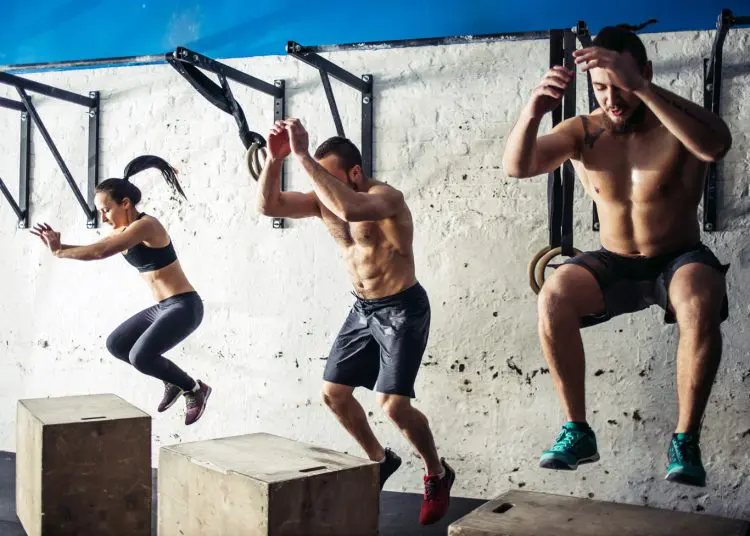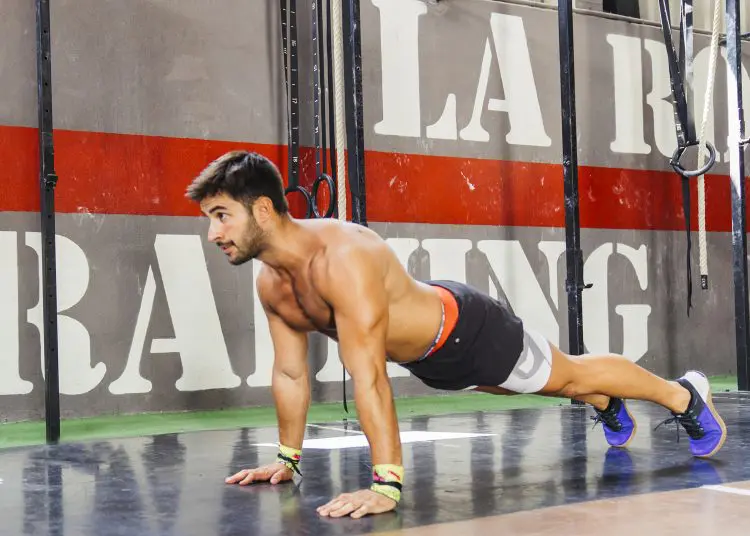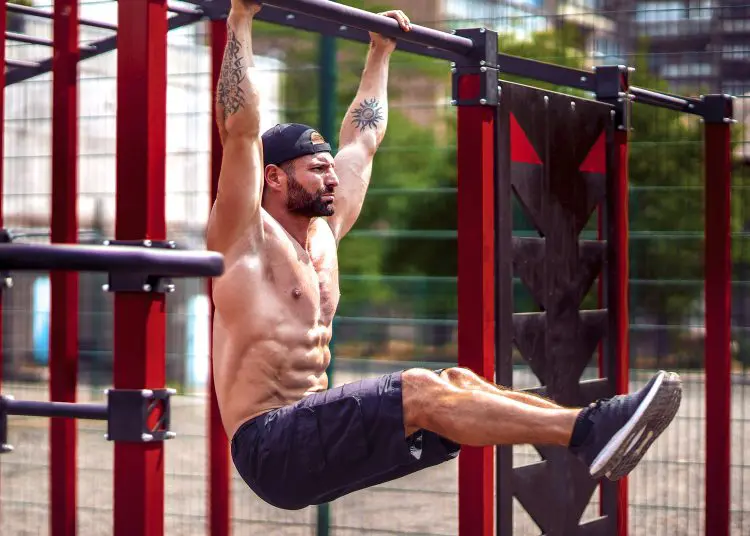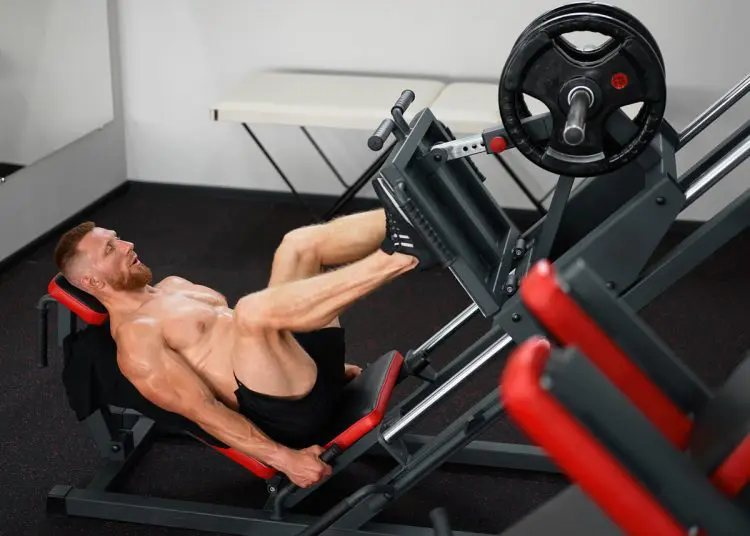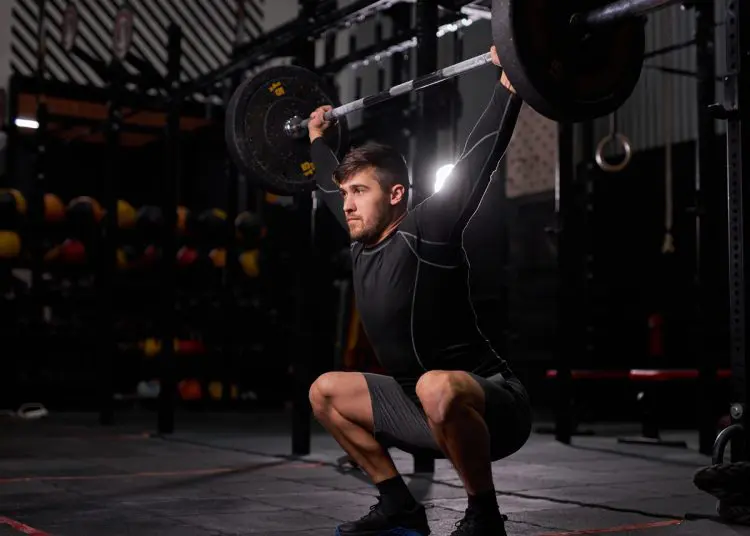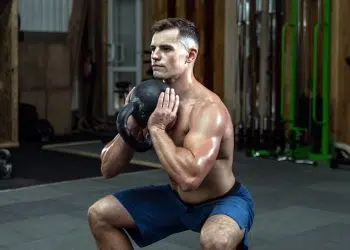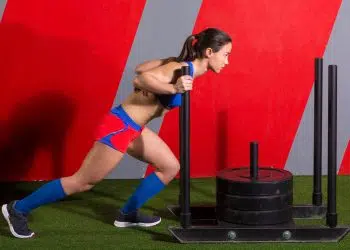Getting in shape can be very time-consuming. You need to dedicate at least a few hours per week to strength training and also need to find time for cardio. Workout methods like HIT and Tabatas can reduce the amount of time you need to spend in the gym, but such high-intensity training methods are not always practical.
Circuit training could be the ideal solution for when time is short, and you need to get your fix of strength training and cardio. In this article, we explain what circuit training is, how to create your own circuit training workouts, and provide you with 10 of our favorite circuit training programs to try.
What Is Circuit Training?
Circuit training was invented in 1953 by R.E. Morgan and G.T. Anderson at the University of Leeds, England (1). It is a training method that combines strength training and aerobic exercises to develop all-around conditioning and fitness in one time-efficient workout. Circuit training is so-called because, originally, the exercises were placed in a circle around the perimeter of a training hall.
Exercises are done back to back with little or no recovery between each one. Participants then rest between laps of each circuit. Circuit training can involve body weight, free weight, and/or machine exercises and often uses a combination of different workout modalities.
Traditionally, circuit training workouts are comprised of 6-12 exercises but can be longer or shorter as required. In circuit training terminology, each exercise is referred to as a station, and the time between each station is called the transition.
Level Up Your Fitness: Join our 💪 strong community in Fitness Volt Newsletter. Get daily inspiration, expert-backed workouts, nutrition tips, the latest in strength sports, and the support you need to reach your goals. Subscribe for free!
With little or no rest between stations, circuit training makes excellent use of your training time. Also, by doing several exercises back-to-back, your heart and breathing rate will be elevated despite not doing any traditional cardio exercises.
There are two main types of circuits – time-controlled and rep-controlled. For time-controlled circuits, each exercise is done for a predetermined time, such as 30 seconds. With rep-controlled circuits, participants do each exercise for a predetermined number of reps, e.g., 15. Some circuits combine both of these methods.
While some circuits involve no rest between stations, others allow short breaks. If rests are permitted, they could be passive or active. Passive rests involve no additional activity other than moving to the next exercise, whereas active rests involve a low-intensity exercise, such as walking or jogging.
Circuit training is a very versatile training method that you can use to achieve almost any fitness goal, from burning fat to improving your cardiovascular fitness to building muscle size, power, and strength. It all depends on the exercises chosen, the resistance used, and how many reps you perform. However, all types of circuit training are intense and time-efficient, so they’re ideal for time-pressed exercisers.
How To Design A Circuit Training Workout
Designing your own circuit training workouts is easy! Just follow these steps…
1. Choose your exercises
Your choice of exercises depends on your training goals and what equipment you have available. Compound exercises are generally the best option for circuit training, as they work multiple muscles for greater time-efficiency and also increase your heart and breathing rate the most. However, you can also use isolation exercises if you prefer.
Circuit training tends to be a full-body workout, so choose exercises for each major body part. However, you can also do upper body or lower body only circuits.
Regarding the number of exercises, choose anywhere between 6-12. Use a lower number of exercises if you are a beginner, and a higher number if you are intermediate/advanced. You can experiment with doing fewer or more exercises once you get used to designing your own circuits.
2. Put the exercises in a logical order
The order of exercises is important. Ideally, you should avoid putting similar exercises next to each other. Too much local fatigue could mean that you are unable to maintain the ideal training intensity. For example, doing push-ups after dips could mean you are too tired to do many push-ups.
Arrange the exercises to avoid overlapping muscle groups. If you’re planning a full-body circuit, consider arranging your exercises in a lower body – core – upper body order.
3. Choose between time-controlled or rep-controlled stations
Both options can work, so it’s up to you which one you select. Time-controlled stations work well when you don’t know how many reps you’ll be able to do with a given weight. Just continue until you run out of time. Also, as you start to get tired from one lap to the next, you can simply do fewer reps per station without having to make any additional adjustments. This is a form of self-regulated training.
Rep-controlled stations work well when you know that you can complete all the prescribed reps. To manage your fatigue, you may need to reduce the rep count lap by lap, for example:
- 1stcircuit – 20 reps
- 2ndcircuit – 15 reps
- 3rdcircuit – 12 reps
Experiment with both control methods to see which one works best for you.
4. Select active or passive transitions
For a more intense workout, move from one station to the next as quickly as possible and with little or no rest. Alternatively, you can take a break between stations. Decide how long this rest period should be, e.g., 30 seconds.
If you choose to rest between exercises, you must then decide between active or passive transitions. For active transitions, pick a low-intensity activity that you can do between each station, such as jogging, step-ups, or jump rope. If you select passive transitions, just move slowly to the next station, catch your breath, and get ready for your next exercise.
Generally, active transitions are best for fat loss, fitness, and more advanced exercisers. Passive transitions are more useful for beginners.
5. Decide on how long you’re going to rest between laps of your circuit
Once you’ve finished your circuit, choose how long you’re going to rest before you do your next lap. This could be 1-2 minutes, or you could wait until your heart rate drops to below a certain level, such as 100 BPM. Alternatively, you could time your rest by the time it takes you to perform a predetermined low-intensity activity, such as jogging a quarter of a mile.
6. Decide how many laps you’re going to do
You can do anywhere between one and lots of laps of your circuit. The number of laps will depend on your fitness, the number of exercises in your workout, and how much time you have available for training. Usually, the fewer stations in a circuit, the more laps you’ll probably do.
The number of laps is also flexible; you might feel more tired than you expected, so you decide to do fewer laps than originally planned. Alternatively, you could find yourself feeling unexpectedly energetic, so you do an extra lap of your circuit.
10 Sample Circuit Training Workouts
No time to design your own circuit training workouts? No problem! Here are 10 of our favorites.
But, before you start, make sure you spend a few minutes warming up and getting your body and mind ready for the workout you’re about to do. 5-10 minutes of easy cardio followed by some dynamic flexibility and mobility exercises will suffice.
You could also do a slow lap of your circuit to ensure that you know how to do all the activities and have selected the correct resistance.
Note: Adjust the following circuits to match your current level of fitness. Reps per station, transition times, number of circuits, and rest periods are for guidance only.
1. Bodyweight only circuit
This circuit is ideal for home use. With no equipment required, it’s all-but excuse free! It’s a time-controlled circuit, so just do as many reps as you can of each exercise. If you are new to circuit training, this is a good place to start.
Level Up Your Fitness: Join our 💪 strong community in Fitness Volt Newsletter. Get daily inspiration, expert-backed workouts, nutrition tips, the latest in strength sports, and the support you need to reach your goals. Subscribe for free!
| No. | Station | Reps | Transition | Laps |
| 1 | Squats | 30 seconds per station | 10 seconds between stations | 3 laps – 60 seconds between laps |
| 2 | Push-ups | |||
| 3 | Crunches | |||
| 4 | Lunges | |||
| 5 | Chair dips | |||
| 6 | Flutter kicks | |||
| 7 | Hip thrusts | |||
| 8 | Wall squats |
2. Playground circuit
This is another bodyweight circuit but, for this one, we’re assuming you have access to a pull-up bar and plenty of space. Our playground circuit is a little more advanced than workout #1.
| No | Station | Reps | Transition | Laps |
| 1 | Squat jumps | 15 | Jog for 30 seconds between stations | 4 laps – 60 seconds between laps |
| 2 | Pull-ups | 10 | ||
| 3 | V-sits | 15 | ||
| 4 | Walking lunges | 15 per leg | ||
| 5 | Push-ups | 20 | ||
| 6 | Reverse crunches | 20 | ||
| 7 | Step-ups | 20 per leg | ||
| 8 | Chin-ups | 10 | ||
| 9 | Diamond push-ups | 15 | ||
| 10 | Sprint | 50 yards |
3. Three-move strength circuit
Our three-move strength circuit is ideal for those times when you need a full-body workout, but you’ve only got a few minutes to train. Load up each exercise with a weight you can lift ten times.
| No. | Station | Reps | Transition | Laps |
| 1 | Squats | 10, 8, 6* | 15 seconds between stations | 3 laps – 60 seconds rest between laps |
| 2 | Bench press | 10, 8, 6 | ||
| 3 | Pull-ups | 10, 8, 6 |
*Do 10 reps of each station for your first lap, 8 reps for the second, and 6 reps for the last lap.
4. Cardio and core circuit
While most circuit workouts tend to work your whole body, they don’t have to. This circuit is all about fat burning and sculpting the midsection of your dreams. This is the perfect circuit for days in between strength training workouts.
Do each cardio exercise at a speed that takes your heart rate to around 80% of your age-adjusted maximum. Use the following calculation:
220 – age in years x 0.80 = 80% of age-adjusted maximum heart rate
| No. | Station | Reps | Transition | Laps |
| 1 | Treadmill | 2 minutes | 15 seconds between stations | 3 laps – 60 seconds between laps |
| 2 | Hanging knee raises | 15 | ||
| 3 | Cable wood chop | 12 per side | ||
| 4 | Rowing machine | 2 minutes | ||
| 5 | Rollouts | 15 | ||
| 6 | Side plank | 45 seconds per side | ||
| 7 | Elliptical | 2 minutes | ||
| 8 | Cable crunches | 15 | ||
| 9 | Russian twists | 12 per side | ||
| 10 | Jump rope | 2 minutes |
5. Barbell only full-body workout
Train your entire body using nothing but a barbell and a flat training bench! This workout is based on Arnold Schwarzenegger’s famous Golden Six training program. Use the same weight for all the exercises to keep your transitions as short as possible. Pump out as many reps as you can of each exercise in the allotted time.
| No. | Station | Reps | Transition | Laps |
| 1 | Squats | 45 seconds per station | 15 seconds between stations | 3 laps – 90 seconds between laps |
| 2 | Bench press | |||
| 3 | Bent-over rows | |||
| 4 | Shoulder press | |||
| 5 | Biceps curl | |||
| 6 | Barbell rollout |
6. Dumbbell only full-body workout
If you train at home, you might not have access to a whole lot of workout equipment. Don’t let that hold you back! For this workout, all you need is a pair of dumbbells. You don’t even need an exercise bench.
| No | Station | Reps | Transition | Laps |
| 1 | Dumbbell deadlifts | 12 | None | 4 laps – 60 seconds between laps |
| 2 | Dumbbell floor press | 12 | ||
| 3 | Renegade rows | 12 per arm | ||
| 4 | Alternating lunges | 12 per leg | ||
| 5 | Alternating shoulder press | 12 per arm | ||
| 6 | Bent-over rows | 12 | ||
| 7 | Romanian deadlifts | 12 | ||
| 8 | Dumbbell side bends | 12 per side |
7. Kettlebell only circuit
All you need for this workout is a single kettlebell. It works your entire body in just eight moves. It’s the ideal workout for when you are short on equipment, space, and time.
| No. | Station | Reps | Transition | Laps |
| 1 | Goblet squats | 30 seconds per station | 15 seconds between stations | 4 laps – 60 seconds between laps |
| 2 | Overhead press (left) | |||
| 3 | Overhead press (right) | |||
| 4 | Swings | |||
| 5 | Single-arm rows (left) | |||
| 6 | Single-arm rows (right) | |||
| 7 | Halos | |||
| 8 | Alternating reverse goblet lunge |
8. Resistance machine circuit
This workout is ideal for those days when you’ve got the gym to yourself. Choose a weight you can lift 12 times for each station.
| No. | Station | Reps | Transition | Laps |
| 1 | Leg press | 12, 10, 8* | None – just walk from one station to the next | 3 laps – rest 1-2 minutes between laps |
| 2 | Chest press | 12, 10, 8* | ||
| 3 | Seated row | 12, 10, 8* | ||
| 4 | Leg extension | 12, 10, 8* | ||
| 5 | Leg curl | 12, 10, 8* | ||
| 6 | Shoulder press | 12, 10, 8* | ||
| 7 | Lat pulldown | 12, 10, 8* | ||
| 8 | Hack squat | 12, 10, 8* | ||
| 9 | Cable biceps curls | 12, 10, 8* | ||
| 10 | Triceps pushdowns | 12, 10, 8* |
*Do 12 reps for your first lap, 10 reps for the second, and 8 reps for your final lap.
9. The bodyweight 300 workout

This circuit is so-called because you’re going to do 300 reps in total. Do each exercise in turn, and only move onto the next one when you’ve completed all the prescribed reps.
This is a race against the clock, so while you can rest during and between each station, you should do your best to keep pumping out the reps.
| No. | Station | Reps | Transition | Laps |
| 1 | Prisoner squats | 50 | None | 1 lap |
| 2 | Push-ups | 50 | ||
| 3 | Pull-ups | 25 | ||
| 4 | V-sits | 50 | ||
| 5 | Lunges | 25 per leg | ||
| 6 | Sit-ups | 50 | ||
| 8 | Burpees | 25 |
10. The power circuit
Power is your ability to generate force quickly. It’s the difference between a heavy but slow squat and a fast squat jump. This circuit combines plyometric exercises with Olympic lifts to train full-body explosive power and speed.
| No. | Station | Reps | Transition | Laps |
| 1 | Power cleans | 6 | 30 seconds between stations | 4 laps – rest 2-3 minutes between laps |
| 2 | Box jumps | 10 | ||
| 3 | Plyo push-ups | 10 | ||
| 4 | Jumping lunges | 10 per leg | ||
| 5 | Kettlebell snatch | 6 per arm | ||
| 6 | Push-press | 6 | ||
| 7 | Medicine ball slams | 10 | ||
| 8 | Medicine ball overhead throw | 10 |
Circuit Training: Wrapping Up
While circuit training is nothing new, it’s a very underutilized type of training. By doing a series of exercises back to back with little or no rest in between, you can develop virtually every aspect of your fitness, from strength to power to cardio. In addition, circuit training is excellent for fat burning.
But, the main advantage of circuit training over other types of workout is that it allows you to get a lot of work done in a relatively short time. In fact, if you do full-body circuits, you can get all the training you need in less than three hours per week; that’s strength AND cardio.
Whether you want to spend less time in the gym, burn more calories, or just shake up your workout routine and do something new, circuit training could be a very valuable addition to your exercise program.
References:
- University of New Mexico: New Insights into Circuit Training (source)
Article Updates Timeline:
Our editorial team experts constantly update the articles with new information & research, ensuring you always have access to the latest and most reliable information.
February 4, 2024
Updated By
Tom Miller, CSCS
Fact Checked By
Dr. Steven Griffin
March 30, 2021
Updated By
Matthew Magnante, ACE
March 26, 2021
Written By
Patrick Dale, PT, ex-Marine
Reviewed By
Editorial Team


